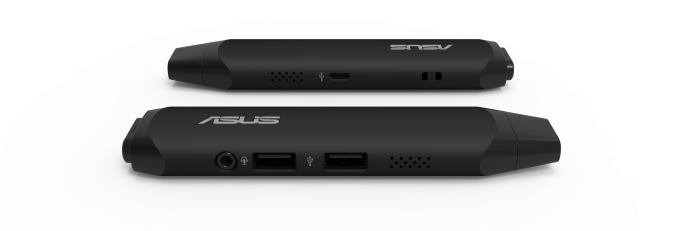Asus Announces the VivoStick PC - A Cherry Trail Compute Stick
by Ganesh T S on September 2, 2015 7:00 AM EST- Posted in
- Asus
- Systems
- Intel
- Cherry Trail
- HDMI Stick

At IFA 2015, Asus is announcing their first PC in the 'compute stick' form factor, the VivoStick PC. As a recap, the Compute Stick form factor is the x86 version of the popular ARM-based HDMI sticks. The first generation x86 Compute Stick came from Intel and used a Bay Trail-T SoC. Despite looking like an oversized thumb drive, the unit was actively cooled.
Asus's first foray into this form factor comes with the 14nm Cherry Trail platform. Unlike Intel's Compute Stick, the Asus VivoStick appears to have a good industrial design. The main differences between the Bay Trail-T Compute Stick that we have already reviewed and the VivoStick PC being announced today are:
- Removal of microSD slot
- Windows 10 Home instead of Windows 8.1 with Bing
- eMCP (multi-chip package) integrating 2 GB of DDR3L and 32 GB of flash memory in a single package, thereby reducing the board area
- 1x USB 3.0 port
The other aspects include availability of a 802.11 b/g/n and BT 4.0 chip for communications. The 138mm x 15mm x 14mm package weighs 70g. The VivoStick also comes in multiple colours. Asus is yet to decide whether to actively cool the device or not.
Asus did not announce any availability dates, but did indicate that the units are expected to have a MSRP of $129. As I have mentioned in multiple reviews, 32GB of primary storage is hardly enough after a couple of major updates. Due to this, the Compute Stick form factor is difficult to recommend as a general PC. However, its sleek and unobtrusive nature as well as low power requirements make it ideal for single purpose computers such as those used in kiosks and other such embedded / industrial applications.











30 Comments
View All Comments
nathanddrews - Wednesday, September 2, 2015 - link
32GB primary storage is small, but you can plug in a low-profile flash drive (like http://amzn.com/B00LLER2CS ) and easily make room for all other applications, media, or games (emulators mostly).watzupken - Wednesday, September 2, 2015 - link
You need to consider that you need to plug in things like mouse and keyboard as well. So easily, you will need to shell out extra money for a USB hub with that comes with external power since it may not be enough power to feed to keyboard + mouse and extra storage.mr_tawan - Wednesday, September 2, 2015 - link
Since it comes with 2 USB ports, I'd plug an flash drive in one port, and mouse+keyboard wireless reciever in the other.That should be enough without resorting to hub, although I don't think any of these two have enough power for external harddrive.
nandnandnand - Wednesday, September 2, 2015 - link
Skip the wireless USB mouse and use a wireless Bluetooth one!mathew7 - Thursday, September 3, 2015 - link
Actually that's not really a solution, as I've found out with 3 devices (i of them an ICS clone, but it was confirmed to me that ICS also has it). The problem is that there is one single radio dealing with WIFI and BT, so the best-case scenario is that you will have mouse skipping while transferring wfi data at lower speeds (e.g. while streaming). Worst-case, wifi data will be interrupted and you will need to "freeze" the mouse to decrease you chanses at "try again" lottery. PS: in theory routers which do not support WMM (old ones) or have it disabled go into the lottery category (it can be called differently depending on brand).neonspark - Thursday, November 5, 2015 - link
ICS is not based on cherrytrail is it?Jammrock - Wednesday, September 2, 2015 - link
It likely uses some form of WIMBoot to minimize the amount of disk space used by the OS. That should, hopefully, keep the OS from using more than 10-15 GB on disk. Even after extended periods of time.https://technet.microsoft.com/en-us/library/Dn5943...
ganeshts - Wednesday, September 2, 2015 - link
The OS is not the only issue.Some software programs only allow install on the primary drive. Even if you specify another drive partition, it puts in plenty of stuff in the primary drive. The User's profile folder is also on the primary drive. Pretty soon, the amount of free space goes down.
Compound the above with the fact that eMMC storage needs some free space to keep operating optimally, it just doesn't make sense to have a Windows PC with 32GB eMMC storage.
32GB is fine for tablet use-cases, or in cases where you know the number / size of programs that you plan to install beforehand. For general-purpose PC use, a 64GB primary drive is what I would recommend at the minimum.
Jammrock - Wednesday, September 2, 2015 - link
For general computing uses I completely agree that more space is needed. Windows store apps only install on the primary drive (unless you are familiar enough with file system junctions/links to move it to a separate drive). But I don't get the general computing vibe from devices like this.This seems more of a Chromebox or Android TV competitor than a desktop replacement. Something your stream content to more than store and process content locally. At least that's what I would use something like this for. More than enough power to run Win10 plus stream 1080p content through JRiver or Kodi/XBMC, and still have enough space to run some other apps or games ... though maybe not many.
neonspark - Thursday, November 5, 2015 - link
why would you even conceive this as a desktop replacement? I mean really. This is a HDPC replacement. It is never meant as a desktop replacement.